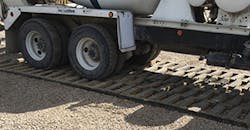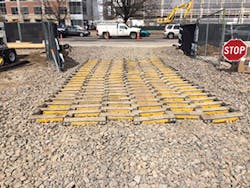Project Profile: Cleaning Up in Colorado
No matter the location on time of year, weather presents its own special challenges, and no industry knows this better than the construction industry. One of the bigger problems is often not as apparent, but can have major consequences if not taken seriously.
Last winter in Denver, CO, Evergreen Caissons was installing foundations for an electrical substation. Throughout the workday, the company’s vehicles transported tools and equipment back and forth between the job site and a nearby laydown yard that could only be accessed by a public road. Any inclement weather presented a challenge, turning the laydown yard into an area of thick mud that was eventually tracked onto the roadway every time tools and equipment had to be transported to and from the job site. This is what is referred to as trackout, a problem encountered on so many construction sites across the country. Trackouts can cause a construction company to be heavily fined.
The conventional method to deal with this problem is to cover the construction site entrance in a layer of rock that will, in theory, clean the tires and undercarriages of trucks, equipment, and other vehicles as they enter and exit the site. This method was used at the laydown yard, but the mud became so thick and sticky that it covered the rock, which was then tracked out onto the roadway as well.
After days of putting down additional layers of rock to cover the mud and hiring a street sweeper to clear the roads, Evergreen Caissons found a solution in nearby Commerce City, where employees at Tracking Pads LLC were working on a product they hope will become the standard for problems like this—the tracking pad.
Tracking pads are heavy-duty mats made from recycled rubber that can be laid down at construction entrances and exits to remove mud, sediment, and other debris from vehicles and equipment. Large voids throughout the mats capture the debris before it can be tracked out onto the roadway. Each mat measures 12 feet square, and the mats can be placed side by side to fit the width of any entrance. Flares can be attached to each end of the mats to accommodate larger turning radiuses. Each mat weighs approximately 2,400 pounds and can be folded up for transport between sites. Durability tests have shown that tracking pads can handle up to 78,000-pound loads with little damage.
“It was just a matter of unloading the mat and laying it out—as easy as that,” says Rich Lovato, foreman with Evergreen Caissons. “We put it on top of the gravel, since it was already there, and figured we might as well use it for a base—quick, easy, and mindless installation that requires little to no work. We were able to let the product go to work for us,” he says.
And it’s not just smaller businesses that are beginning to take notice. Several city, state, and federal governments have also expressed their interest in tracking pads, and the pad is now included on the Colorado Department of Transportation’s (CDOT’s) Approved Product List.
Back at the laydown yard, Evergreen Caissons expressed its satisfaction with the tracking pads, saying that they are doing their job and the only regret was not using them from the beginning.



